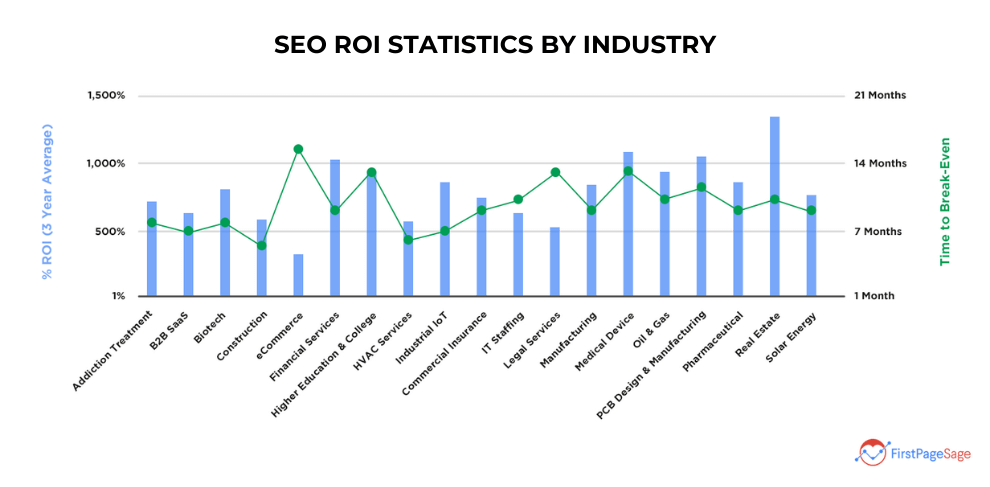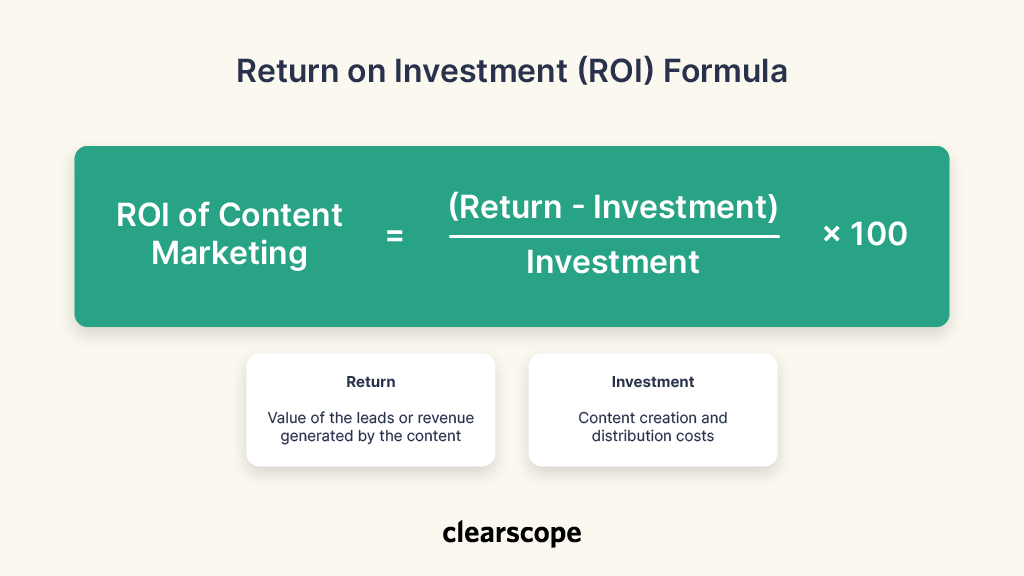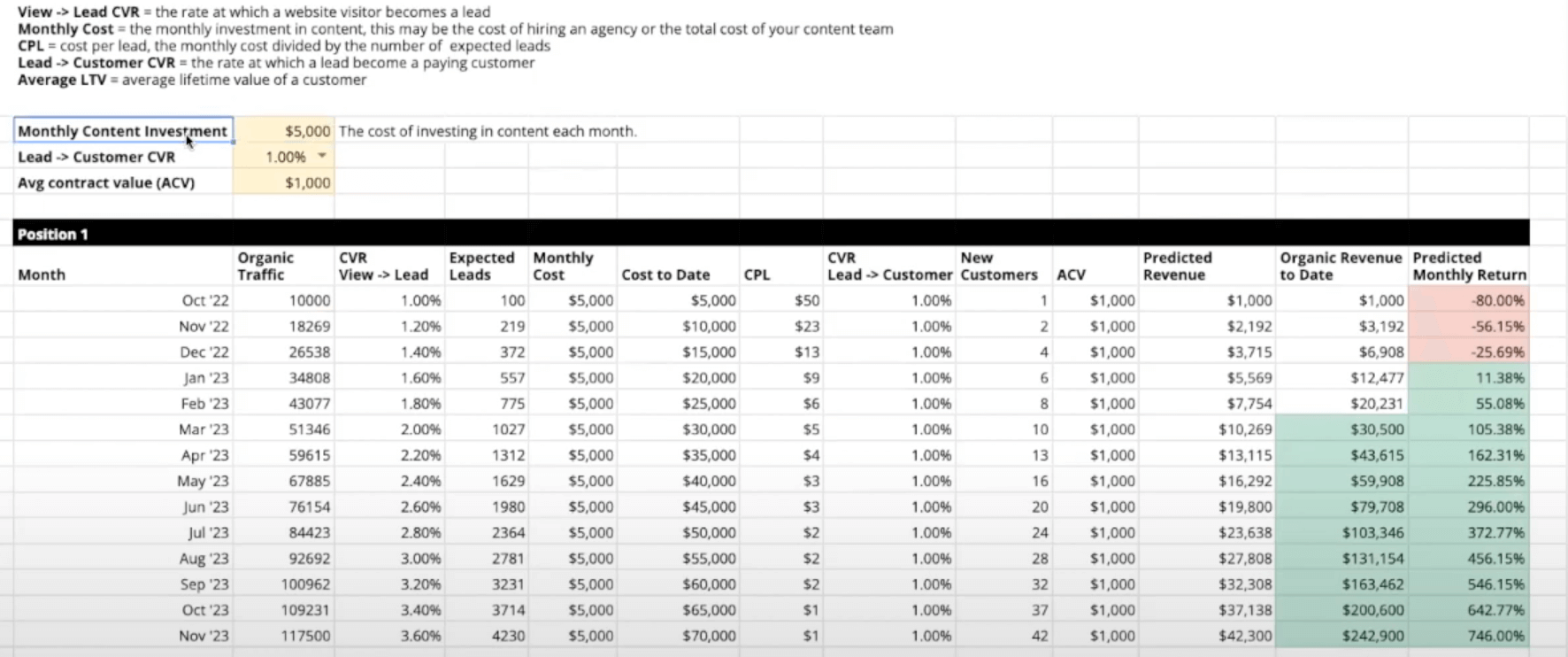How To Measure and Predict ROI for Your Content Marketing Strategy
Topic: Content Marketing
Published:
Written by: Bernard Huang
Content marketing often feels more like an art than a science. And for a long time, it was difficult for marketing departments to accurately attribute results to their efforts.
Unfortunately, that means it can be more challenging to justify the investment into content marketing, especially when you’re competing with a sales team that can draw a clear line from their work to revenue.
The good news is that the tools for tracking and understanding the impact of content marketing have improved, giving B2C and B2B marketers the data they need to measure their impact.
That’s why it’s essential that content marketers today understand how to calculate the return on investment (ROI) of their content marketing strategy and communicate that value to leadership.
Note: Clearscope is our product. We’re proud of what we’ve built and believe we have the best content optimization and monitoring platform on the market. Request a personalized demo.
What is content marketing ROI?
Content marketing ROI is a percentage that shows you how much revenue your efforts generated compared to the money invested in the initiative. In short, it’s a metric that shows the effectiveness of your content marketing strategy.
Content marketing ROI answers the question of are you profitably converting your target audience into paying customers.
A content marketing ROI of 100% indicates that the revenue you generated is equal to your costs. In other words, the strategy broke even.
If your ROI is less than 100%, that means you spent more money than you made. Conversely, anything higher than 100% means you made more money than you spent on content creation and distribution.
The importance of content marketing ROI
According to the CMI’s 2022 B2B Content Marketing Research, 90% of the top performers measure their content performance. In contrast, only 39% of the least successful respondents said they tracked the results of their content marketing efforts.
Calculating your ROI can help you explain the value of your content marketing strategy to the rest of the organization.
Understanding the overall impact of your content marketing strategy is essential for measuring whether or not you achieved your goals. It’s also helpful for justifying investment into the content marketing strategy, especially when you’re looking to scale operations.
What is a good ROI for content marketing?
One study found that, on average, content marketing costs 62% less than traditional marketing but brings in 3x more leads.
However, there’s no universal ROI standard that works for every digital marketing team. At the very least, you want an ROI higher than 100%, which shows that your content marketing campaign made more money than it cost.
Beyond that, it’s helpful to consider the relative performance of your strategy in two ways: internally and externally.
First, you can compare the ROI of your content marketing strategy to the ROI of other marketing strategies. This helps you determine which marketing efforts are most effective.
For instance, let’s say your content marketing has an ROI of 300%, and your paid ads strategy has an ROI of 180%. This means that for every $1 invested, content marketing can generate $3, while paid ads only bring in $1.80.
In this instance, you can see that content has a higher return. With this information, you may decide to shift more of your marketing budget to content instead of ads.
Second, you can compare your content ROI with industry benchmarks to see how well you’re keeping up with the competition. While you may not have access to everyone else’s ROI data, you can use reports and surveys to figure out average numbers.
For instance, FirstPageSage found that software-selling B2B companies have an average search engine optimization (SEO) ROI of 702%.

Graph of SEO ROI statistics by industry (image source).
How to calculate content marketing ROI
To measure ROI, divide your net return (total return minus costs) by your total costs (content creation and distribution) and multiply by 100 to get a percentage. For example, if you spent $1,000 on content and it brings you leads worth $4,000, then your net return is $3,000, and your ROI is 300%.
Content marketing ROI formula
The content marketing formula can be shortened to “revenue minus costs, divided by costs, expressed as a percentage” or:
ROI of content marketing = [(Return - Investment) / Investment] x 100
where
Return = Value of the leads or revenue generated by the content
Investment = Content creation and distribution costs

Return on investment (ROI) formula.
Taking a closer look at costs, creation costs include the salaries or outsourcing fees required to create content assets. This may also include services and essential tools to create quality content, such as keyword research and content optimization software.
Distribution costs include paid ads and fees for distribution software such as content management systems, social media schedulers, and email marketing software.
ROI calculation example
Content marketing strategies rely on more than just copywriting. When adding up costs, you want to include all relevant inputs such as keyword research and graphic design.
Let’s see how those numbers might break down using the example of a piece of content that cost $1,000 and generated a total return value of $4,000.
Costs
Research and writing (outsourced): $750
Editing (2 hours valued at $25 per hour): $50
Image creation (outsourced): $100
Paid ads: $100
Total = $1,000
Return
40 top-of-funnel leads (valued at $100 per lead): $4,000
Total = $4,000
You can plug those values into the formula to get:
ROI = [(Return - Investment) / Investment] x 100
ROI = [($4,000 - $1,000) / $1,000] x 100
ROI = ($3,000 / $1,000) x 100 = 300%
In other words, for every $1 spent, this piece of content generated $3 of leads.
Content marketing KPIs
Revenue isn’t the only benefit of a successful content marketing strategy. In fact, CMI’s research found that 80% of respondents listed brand awareness as one of the top marketing goals achieved when investing in high-quality content.

Goals B2B marketers have achieved by using content marketing successfully in the last 12 months (image source).
Given this, you can adjust the ROI formula to help you track performance toward non-revenue objectives by measuring the return on other key performance indicators (KPIs), such as:
Number of qualified leads generated
Average time on page
Social engagement
Email engagement
Brand mentions
Bounce rate
Page views
Use analytics tools such as Google Analytics, Adobe Analytics, or similar tools to report on the above KPIs.
What is ROI modeling?
ROI modeling is the process of using data and assumptions to predict the ROI of a particular investment, such as a new content marketing initiative. When comparing several strategies, you can use ROI models to help you identify high-growth opportunities.
How to model and predict SEO content marketing ROI
When modeling the ROI of an SEO content marketing strategy, your goal is to predict how much revenue you can generate based on your content’s performance for a given set of keywords.
To see the full process in action, watch our webinar, How to Model and Predict ROI from Content Marketing, featuring David Khim, co-founder of Omniscient Digital.
David uses the following steps to show how you can set up the model in a spreadsheet template and predict the earnings potential of an SEO content marketing strategy:
Modeling preparation
Before starting your model, you want to come prepared with the following information.
The goal of your content marketing strategy
Description of your strategy and types of content (blog posts, case studies, landing pages, infographics)
The high-level topics you want to associate with your brand
List of target keywords with their monthly search value
Baseline conversion rates of the customer journey (website visitor to lead, lead to customer)
Estimate of your average contract value (ACV) or customer lifetime value (LTV)
Take the model preparation a step further by building in a layer of automation to collect the above metrics from your CRM (e.g., HubSpot, Salesforce) and analytics tools.
Assumptions
Along with the information you’ve already gathered, you’ll also base your predictive model on a few assumptions. These are researched or ballpark guesses for the information you don’t have yet.
The main assumption you’ll need is the click-through rate (CTR) for your content based on how well it ranks on search engine results pages (SERPs).
Since you can’t know the actual CTR unless you publish the piece of content, you have to use a guess for the model. One good way to make your assumption is by finding research that gives an average CTR based on your page’s rank.
For instance, FirstPageSage found that the CTRs for the top three positions are 39.8% for first, 18.7% for second, and 10.2% for third. Since these are SEO results, we’ll also assume that it will take six months before a new post can rank in one of the top three spots.
You may also have to estimate values for your conversion rates, average contract value, or customer lifetime value if you don’t have enough historical data yet.
Modeling SEO traffic
Now you’re ready to model the organic traffic generated by your strategy. For this step, you’ll need your list of keywords with monthly search volume and your CTR assumptions.
For each keyword, you can predict a range of monthly traffic generated by multiplying the search volume and CTR.
Let’s say one of your target keywords is “competitive analysis tools," and it has a monthly search volume (MSV) of 2,400.
If, after six months, your post for competitive analysis tools ranks in the first position, you would expect to capture 39.8% of the 2,400 monthly searches or a total of 955 new visitors.
We can also figure out what your expected monthly website traffic would be if you ranked in the second and third positions.
Keyword: competitive analysis tools (2,400 MSV)
Position 1 (39.8% CTR): 955 visitors
Position 2 (18.7% CTR): 448 visitors
Position 3 (10.2% CTR): 244 visitors
When you do this for all keywords, you can get a range of estimated traffic based on your average page rank.
Modeling business growth
The next step is to connect the increase in traffic with the impact on lead generation and revenue to predict the business impact of your SEO content marketing strategy.
First, predict the number of leads generated by each website visit using conversion rates. For this example, we’ll say that 1% of website visitors sign up for your email newsletter and become a lead.
Here’s how many leads you would generate based on different page ranks:
Keyword: competitive analysis tools (2,400 MSV)
Position 1 (39.8% CTR): 9 leads
Position 2 (18.7% CTR): 4 leads
Position 3 (10.2% CTR): 2 leads
Now, it’s time to predict revenue by finding the value of each new lead.
Top-of-funnel lead value = % that convert into new customers x revenue generated (ACV or LTV)
For this example, let’s say that 1% of these potential customers convert and make a purchase.
Top-of-funnel lead value = .01 x $6,000 = $60
When you plug in the value of each lead, you can predict the revenue-generating potential of each ranked position.
Keyword: competitive analysis tools (2,400 MSV)
Position 1 (39.8% CTR): $540
Position 2 (18.7% CTR): $240
Position 3 (10.2% CTR): $120
Based on these assumptions, this piece can generate $120 to $540 per month if it ranks in one of the top three positions.
You can do the same work for all of the keywords on your list to see the potential monthly revenue of the entire strategy.
Modeling ROI
Once you’ve estimated the revenue potential of all of your new blog content, it’s time to compare that with costs to figure out your ROI.

ROI model showing monthly revenue growth for SEO content marketing strategy.
With this model, we’ll be comparing total monthly revenue with total monthly costs.
Adjusting levers
One of the values of using a model spreadsheet is the ability to change your inputs and view different scenarios. These inputs are also known as levers, and they are the values that have an impact on your total revenue and ROI.
Input levers in this model include:
Content costs
CTR assumptions
Visitor-to-lead conversion rate
Lead-to-customer conversion rate
Average contract value
Lifetime value of a customer
For example, you can compare what happens to your traffic, leads, and revenue if you change your first-position CTR from 39.8% down to 30%. You could also see what happens if you convert 2% of email subscribers to customers instead of 1%.
Once you’ve created the model, you can change levers to view ROI predictions based on different scenarios.
Tips for ROI modeling
When using models to predict performance, it’s important to remember that they aren’t perfect. Your model will only be as good as the data and assumptions you put into it.
Here are a few tips to keep in mind when predicting ROI with models:
Adjust levers to see what happens if you don’t meet all performance goals.
Use conservative assumptions (don’t just explore best-case scenarios).
When using historical data, choose averages, not best performances.
Don’t overcomplicate the model or spend too much time perfecting it.
Models aren’t going to predict the exact performance of a plan. Instead, they’re decision-making tools that help you see if your plan has high-growth potential.

Tips for modeling content marketing ROI
Final thoughts: How to measure and forecast content marketing ROI
Understanding the ROI of any marketing strategy is essential for figuring out and demonstrating its effectiveness to your company. While you can only calculate the actual ROI after running a campaign, you can use models to predict various ROI scenarios.

What Is User Intent? It’s Your Key to Boosting Rankings, Leads, and Conversions
What is user intent, and why is it important for SEO? Learn the basics here.
Read moreHow to Create the Perfect SEO Content Brief in the Era of Ai-Assisted Content
Discover how to craft SEO content briefs that focus on people-first content, even in the AI era. Learn to streamline content production and boost organic traffic with actionable, user-centered strategies.
Read moreKeyword Mapping: What It Is and How to Map to Your Purchase Journey
Learn what keyword mapping is and how to implement it for your website.
Read more